In Search of Queen Victoria’s Voice
The British monarch was present when a solicitor demonstrated one of the earliest audio recording devices. But did she really say “tomatoes”?
/https://tf-cmsv2-smithsonianmag-media.s3.amazonaws.com/filer/20111006091011queen-victoria-voice-recording-small.jpg)
It is a woman’s voice, but it sounds as though it comes drifting toward us across some vast and unbridgeable distance. It is all but drowned out by the snaps and the crackles and pops of what is by any standard a primitive recording. And yet—listened to over and over again—the voice does begin to sound refined. Perhaps even a little bit imperious.
The words that the woman speaks are muffled, but it is possible to make at least a few of them out. Some people have sworn that they can hear “tomatoes,” for example, blurted out toward the end of the track. But what about the very first syllables preserved on the recording—a 20-second audio track believed to have been made more than 130 years ago, late in 1888, in the earliest days of the recording industry? Is that really the voice of Her Imperial Majesty Queen Victoria? And, if it is, can she really be welcoming her listeners with the words: “Greetings, Britons and everybody”?
There is no real doubt that Britain’s longest-reigning monarch allowed her voice to be recorded in that long-ago fall. The man who made the recording freely discussed it and it is recalled in a letter in the Royal Archives, dated 1907; the incident also rates a passing mention (without a source attribution) in Elizabeth Longford’s exhaustive biography of the Queen, Victoria R.I. The question is what happened to the recording after it was made—and, in a broader sense, why it matters whether it still exists. The search for the recording takes us from the New Jersey laboratories of Thomas Edison to the Highlands of Scotland, and from the archives of the Rolls-Royce motor company to the vaults beneath London’s Science Museum. Before we set of on that trail, though, we first need to understand why anyone should be interested in a few utterly unimportant phrases spoken by a long-dead queen.
The answer to that question tells us much about the nature of historical evidence, for the point, surely, is that the immediacy of the medium is key. This can be true of other sources, too—a letter written by an Assyrian teenager in about 700 B.C., complaining from his boarding school that his friends all have more fashionable clothes than he does, similarly telescopes the centuries, making us feel that we can almost understand what was an immeasurably alien time and place. But if mere words possess the unsettling ability to bring the past sharply into focus, the same is doubly or triply true for photographs and sound recordings.
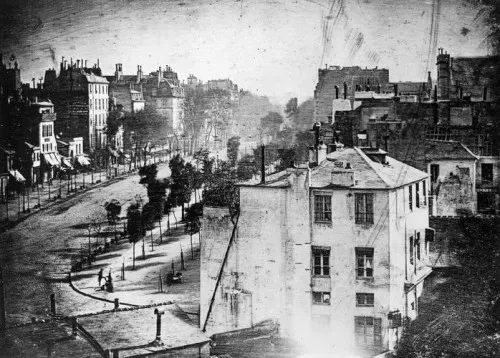
There is, for instance, something unutterably eerie about the earliest photograph to show a human being. Shot from a window high above the Boulevard du Temple in Paris in 1838, using the brand new daguerrotype process, the plate captures a solitary gentleman who has stopped to have his shoes shined. He seems to be all alone in what was actually a busy street—the carts and the people around him were moving too fast to be fixed by the 10-minute exposure. And this illusion of solitude lends the plate a sinister feel; it is as if the bootblack and his customer are the only people of any interest to this first camera on this first day. The gentleman himself is such a shadowy presence—fixed imprecisely by the length of the exposure—that he becomes, in effect, an everyman. That makes it easy to project ourselves onto him, almost as though it is we who will tip the shoeshine boy and stroll off into the Paris of the July Monarchy.
The earliest sound recordings, on the other hand, offer direct connection with one long-dead individual—and, in the case of the voices of the famous, shrink the distance between us: in terms of time, but also stature. They humanize, offering access to men and women who otherwise seem grand and distant. You can hear this effect for yourselves, because a large number of the great and good of the Victorian era made recordings of their voices, among them Robert Browning and Alfred Lord Tennyson, Sarah Bernhardt, Florence Nightingale, and monarchs such as Tsar Nicholas II and Kaiser Wilhelm II.
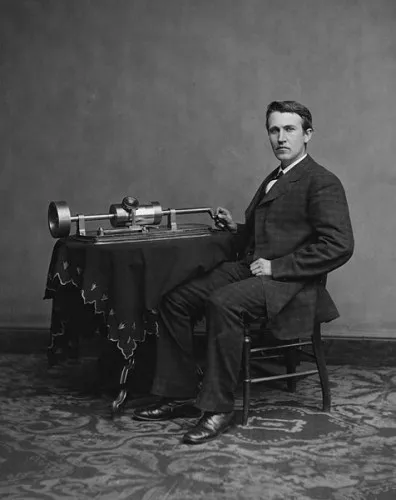
These primitive tracks, however, were laid down relatively late—for the most part in the 1890s and, in the case of the two monarchs, in the early 1900s. Queen Victoria’s voice was captured earlier, and using techniques that were subtly different from those employed in later years. To understand those differences, we first need to travel back to Menlo Park, New Jersey, to the world-famous workshops of a young Edison, who in the fall of 1877 perfected the earliest example of the phonograph.
The invention was the product of research aimed at making a device that could record a conversation conducted over the newly invented telephone. Edison realized that a diaphragm fitted with an embossing point such as a needle could be set up to register the sound of human speech and record those vibrations in the form of marks of varying amplitude made in some form of recording medium—at first the inventor used paraffin paper, then tin foil. Played back via a speaker using a similar needle unit, the device could retransmit the sounds.
Edison’s idea was not entirely original. In the 1860s, a Frenchman by the name of Édouard Léon Scott de Martinville had developed a machine known as a “Phonautograph,” which recorded much as the phonograph would do, but without retransmitting sounds. Instead, the Phonautograph produced a visual representation of sound waves by connecting its diaphragm to a bristle brush set up to trace lightly over a piece of paper that had been impregnated with soot. Scott’s genius was confirmed a few years ago, when the scientists of the First Sounds project succeeded in converting the sooty handful of surviving “phonautograms” back to audio; it is now possible to hear Scott’s own voice singing Au Clair de Lune as early as May 1860. (This, of course, makes it permissible to hope that other early recordings may still exist. There was even a rumor—which emerged during the 1960s but which, sadly, has been comprehensively dismissed—that Scott visited the White House during the Civil War and secured a Phonautograph recording of another famous voice: that of Abraham Lincoln.)
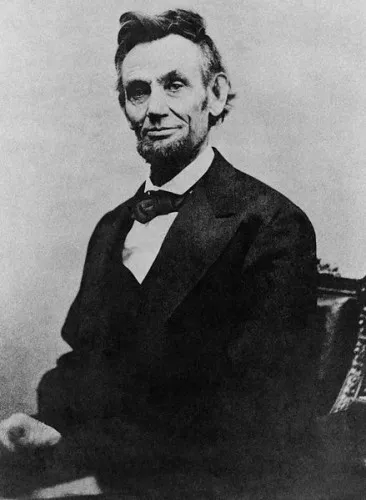
Whatever the source of Edison’s inspiration, his work at Menlo Park bore fruit in 1877, and by early 1878, word of the Phonograph’s invention was out. The invention was patented that February, and there was a brief fad for making home recordings using it. But Edison’s tin foil covered cylinders barely qualified as a permanent recording medium. They were fragile and prone to tearing, and the messages recorded on them soon wore out. It was not until several years later, when Alexander Graham Bell mastered the technique of making recordings in wax, that the Phonograph became more than a toy. Edison promptly returned to the audio field (he had spent the previous few years inventing his electric light bulb), developing a tough wax cylinder that was vastly more durable than the flimsy wax-coated cardboard tube that Bell had used; it could even be re-used by shaving the outer layer of wax from the cylinder with a knife. The upshot was an outburst of intense competition between the Phonograph and Bell’s machine, the Graphophone.
In 1887, Edison he sold his U.S. patent rights to a Pittsburgh millionaire named Jesse H. Lippincott and the European rights to Colonel George Gouraud, a Frenchman who had come to the United States in 1839 and served with distinction with the Union army during the Civil War. In 1888, Gouraud sailed for Britain, where he set about establishing a market for the Phonograph.
Gourard was an astute businessman with a keen eye for publicity. The local historian Chris Goddard notes that, shortly after arriving in London, the Colonel moved into a property south of the city, which he quickly turned into
an all-electric house, or as all-electric as could be achieved in the 1880s. Gouraud’s boots were cleaned by electricity, his carpets brushed by electricity, lighting was by electricity and he rode a tricycle with an electric motor.
Gouraud followed up that triumph by arranging for a Phonograph to go on display at the Crystal Palace: a vast iron-and-glass structure just south of the River Thames which by the late 1870s was operating as the world’s first amusement park, a combination exhibition center, museum, sporting venue and concert hall. Showing his keen eye for the main chance, the colonel persuaded well-known visitors—including the prime minister, William Gladstone—to record their voices for posterity. The recordings attracted great interest, and Edison’s improved Phonograph was launched.
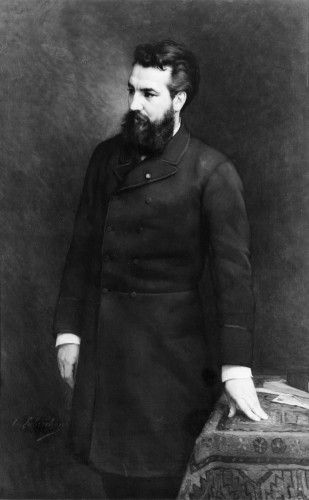
Bell, meanwhile, had not been idle. His Graphophone still enjoyed a couple of advantages. It reproduced sound more clearly than the Phonograph, and needed less adjustment, which meant that it was far more suitable for private use. Just as important, Bell’s British agent was Henry Edmunds, an engineer, born in Halifax in Yorkshire, who was not only a considerable mechanic in his own right, but very nearly Colonel Gouraud’s equal as a publicist.
Edmunds had actually been involved in the recording industry from its earliest days: writing in Reminiscences of a Pioneer, a series of magazine articles he published half a century later, he claimed to have actually been in Edison’s laboratory on the day in November 1877 when the inventor made his first successful recording with the Phonograph. Now, 11 years later, Edmunds had a trump card to play. His solicitor, Sydney Morse–an early investor in the British Graphophone company—had royal connections. Indeed, Morse had not only played rugby for England (in those days a fair indicator of elevated social status) but was also a close friend of Queen Victoria’s French governess and an occasional visitor to the annual royal summer party at Balmoral. In the autumn of 1888, Morse took a Graphophone and several cardboard cylinders and headed north by train. The Graphophone’s celebrity, Edmunds explained, had
reached the ears of Royalty and the aged Queen Victoria expressed a desire to have a demonstration…. I could not go myself, but my friend and solicitor, Mr Sydney Morse, took an instrument to Scotland and had the honour of showing it to the delightful old lady. Abandoning the usual Royal reserve, Her Majesty expressed her unqualified delight; so much so that Mr Morse was emboldened to request the Queen to speak a few words.

Morse’s daring in making such a request should not be underestimated. Queen Victoria was noted for her reticence; always bothered by her physical appearance—she stood under five feet tall and once complained that “everybody grows but me”—she had a lifelong horror of autograph hunters, and a distaste for souvenir collectors. On the only other occasion she is known to have made a cylinder recording—10 years later, in 1898, as part of an effort orchestrated by the British Foreign Office to impress the forward-looking Emperor of Ethiopia, Menelik II—she did so only after insisting the cylinder be destroyed as soon as it had been played to him. On at least three occasions, the Queen declined invitations from Edison’s Phonograph Company to record celebratory messages.
But surrounded by family and friends at Balmoral, Sydney Morse declared, Victoria unbent enough to speak a few words in the general direction of the Graphophone’s mouthpiece. Morse operated the treadle—the Graphophone, was not electrically powered—and on his return to London delightedly showed Henry Edmunds the product of his labors: “a small black cylinder with a few black spiral lines traced upon it, containing the record of the voice and speech of the celebrated Queen.” Added Edmunds: “He declared that it was his most cherished possession; and would pass it to his children as his chiefest treasure.”
After Morse made the recording, Elizabeth Longford notes, he was sternly warned “not to tour the country playing it,” so the visit yielded no real publicity opportunites. But both Edmunds and Morse recognized the historical value of the recording. Family testimony suggests that Morse kept hold of the cylinder well into the 1920s. The recording was last heard of sometime in the 1920s, when Morse played it for his grandchildren on the same treadle-operated Graphophone. Then he died, and it disappeared. And that was that for 50 years.
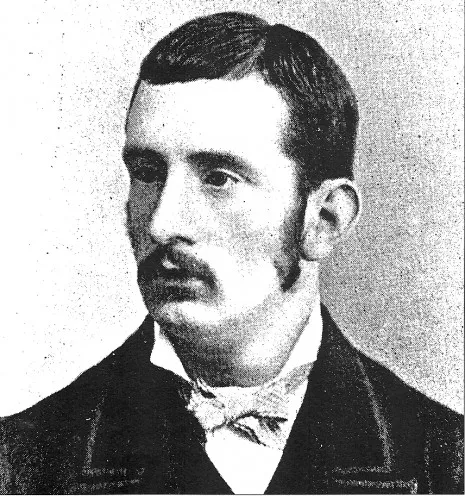
Memory of the voice of Queen Victoria had faded almost entirely when, in the late 1970s, interest in Henry Edmunds and his work revived as a result of another of the Yorkshireman’s memorable achievements: in 1904, as the motor industry took off, Edmunds had introduced an aristocratic car dealer named Charles Rolls to the engineer Frederick Henry Royce. Seventy five years later, as Rolls-Royce prepared to celebrate its anniversary, an editor at the Rolls-Royce Motors house journal commissioned journalist Paul Tritton to profile Edmunds.
Having rediscovered Morse and the Graphophone, Tritton became obsessed with the idea of relocating the lost cylinder. He inspected Henry Edmunds’s will at London’s Principal Probate Registry. To his disappointment, it contained no references to Graphophones or cylinders, and Edmunds’s grandchildren remembered nothing.
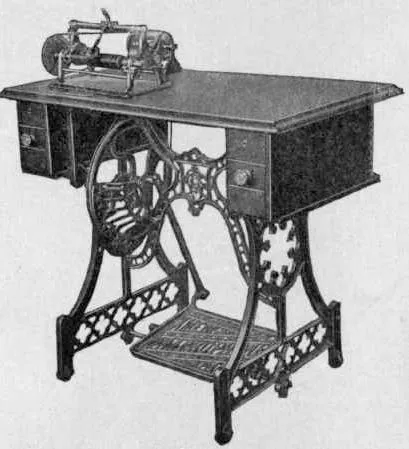
But two of Sydney’s grandchildren, Mary Barton and David Morse, did recall an old Graphophone cylinder that had been played for them during their childhoods. Mary’s recollection was hazy–”All I can recall is that it was a jumble of words,” she said, “it was all rather boring for a small child.” But David Morse recalled not only the cylinder, but also what he had heard on it.
“There was a total silence,” he remembered of the day he had last heard the recording, in 1922,
That is, a loud continuous scratching for the first minutes, then a short sentence in a female voice, of which one word was ‘tomatoes,’ then a further mechanical scratching until the end.
Mention of tomatoes, of course, merely added problems to the puzzle. Morse’s description bore very little resemblance to the recording first described by Elizabeth Longford as early as 1964—Victoria’s biographer had reported that it consisted of courtiers telling German jokes, after which “Her Majesty spoke a few words.” But David Morse insisted
that Queen Victoria, like most people not professional actors, who are asked to ‘say something,’ simply so that their voices shall be heard and not for any purpose of communicating, was very shy when faced with a large horn which she had to address, and was only cajoled into speech when the recording time was nearly over by my grandfather indicating various objects in the room which might provoke some sort of comment from Her Majesty.
Although Tritton now knew that the cylinder had still existed as late as 1929, it was only when he spoke to John Holgate, a retired clerk who had worked for Morse in the late 1920s, that he uncovered the first clues as to its likely current whereabouts. Holgate remembered that attempts had been made to donate Sydney Morse’s original Graphophone to the Victoria and Albert Museum, and Tritton discovered that the V&A retained a file of correspondence showing that the offer had been passed next door to the Science Museum.
At first this new lead seemed to lead nowhere. A letter in the Science Museum’s files noted that W.S. Plummer, the museum’s expert on early recording technology, had rejected the offer of the Graphophone, which was missing “several vital parts.” Plummer had accepted an old cardboard cylinder and a few accessories, but—in a letter dated June 10, 1929—explicitly rejected the Morse family’s offer of “a wax cylinder record in which Queen Victoria speaks a few words.”
It was only when Tritton determined to make one last hunt through all the clues he had assembled that he noticed an anomaly in Plummer’s correspondence. Plummer had described being offered a “wax cylinder” containing Queen Victoria’s voice. But Tritton knew that Morse had made his recording on a Graphophone, which used a wax-coated cardboard cylinder. With a jolt, he realized that while the Science Museum correspondence confirmed that Plummer had rejected a wax recording, he had acquired the Morses’ solitary example of a Graphophone cylinder. It “should certainly be accepted as it is the predecessor of the wax record and is not represented in the collection,” Plummer had written.
A call to the Science Museum confirmed that it still retained Morse’s Graphophone equipment. Examination under a high-powered microscope revealed a trio of narrow grooves cut into the fragile wax. Somebody had made three separate recordings on the cylinder.
Even then, Tritton’s long hunt was scarcely at an end. The Science Museum did not possess a Graphophone on which the cylinder could be played, and it took a further decade for modern recording technology to come up with a way of turning the spidery grooves on the old cylinder into a digital recording that could be played.
It was not until June 11, 1991, that Sydney Morse’s cylinder was played for the first time in more than 60 years, with results that were described by Nigel Bewley of the British Library Sound Archive:
Some words can be made out: “My fellow Britons…” at the beginning and “I have never forgotten” at the end.
Careful listening later added a second phrase faintly discernible in the middle: “The answer must be….”
According to Paul Tritton, who has listened to the recording more often than anybody else, the unintelligible portions of the recording consist of roughly 40 words or syllables. There is no guarantee that the voice heard is Queen Victoria’s—Bewley suggests that the monarch “may have instructed an aide to make the recording on her behalf.” But Sydney Morse’s story, and Edmunds’, surely suggests that the Queen’s voice was recorded. And if the Morse family found only a single Graphophone cylinder in Sydney’s office–and if Morse regarded one cardboard tube as his “chiefest treasure”—the evidence for the Science Museum’s Graphophone cylinder being the one that was recorded at Balmoral in 1888 seems reasonably solid.
Some mysteries remain. There is no trace of the word “tomatoes” on the digital recording. And it remains to be seen whether the indecipherable portions of the message might yet be recovered by further advances in recording technology. Tritton himself has found that every listener has his or her own interpretation—including the person who insisted, on first hearing the recording, that the words “Greetings, Britons and everybody” could clearly be heard on it. “Perhaps,” Tritton suggests, “someone with exceptionally sensitive hearing—a blind person, for example—would have more success?”
Did the Science Museum cylinder record Queen Victoria’s voice? You can judge for yourself by listening to Track 2 of Sydney Morse’s Graphophone cylinder here.
Sources
James Bone. ‘Queen Victoria will speak again thanks to science.’ The Times (London), July 27, 2004; Abraham Demoz. ‘Emperor Menelik’s Phonograph Message to Queen Victoria.’ Bulletin of the School of Oriental and African Studies 32 (1969); Meaghan Hennessey and David Giovannoni. ‘The world’s oldest sound recordings played for the first time.’ First Sounds.org, March 27, 2008. Accessed September 27, 2011; Elizabeth Longford. Victoria R.I. London: Pan, 1966; Jody Rosen. ‘Researchers play tune recorded before Edison.’ New York Times, March 27, 2008; William Shaman et al. More EJS: Discography of the Edward J. Smith Recordings. Greenwood : Greenwood Press, 1999; Paul Tritton. The Lost Voice of Queen Victoria: The Search for the First Royal Recording. London: Academy Books, 1991; Walter L. Welch et al. From Tinfoil to Stereo: the Acoustic Years of the Recording Industry, 1877-1929. Gainesville : University Press of Florida.
/https://tf-cmsv2-smithsonianmag-media.s3.amazonaws.com/accounts/headshot/mike-dash-240.jpg)
/https://tf-cmsv2-smithsonianmag-media.s3.amazonaws.com/accounts/headshot/mike-dash-240.jpg)